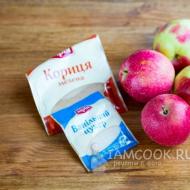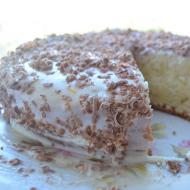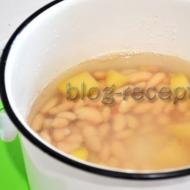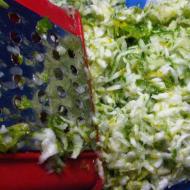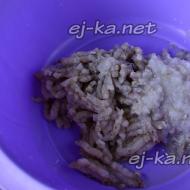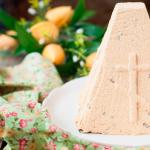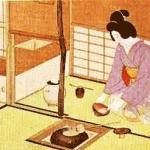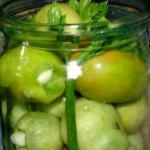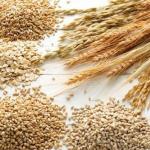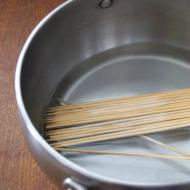
Chinese black tea Puer. Pu-erh tea: beneficial properties and contraindications. Types and varieties of puer tea
One of the mysterious drinks is pu-erh. What kind of tea is this, how it is made, how it is useful and harmful, how to brew and drink it correctly - the answers to all these questions are in the article.
Let us immediately note that pu-erh is made from the same plant as any other tea. All the differences are in the processing method. This potion is fermented tea.
This drink is very healthy, although it has a specific taste. Although many people like him just for this reason.
Leaves for the future pu-erh are collected from an ordinary tea tree, selecting large ones. After this, they are prepared like any tea: first dried in the shade, then steamed at high temperature to completely remove moisture. After this, they are crushed - manually or using special devices.
The leaves continue to dry in the sun or simply in a dry, warm room. After this, pu-erh is prepared directly using special technologies:
- Shen pu-erh, or raw pu-erh, is a product of natural fermentation that can last seven to eight years. The drink made from such leaves is light and transparent; it is also called green pu-erh.
- Shu-puer, or black puer, is black in color with a rich taste. Its production takes less time - tea leaves are moistened in water, placed in tight containers and left for three to four months. Fermentation takes place artificially.
The intoxicating effect of pu-erh tea
Pu-erh is a famous noble tea that is produced exclusively in China. This is one of those drinks that every tea lover should definitely try at least once in their life. If you decide to taste pu-erh tea, the effect may be a little unexpected - this drink is famous for its intoxicating effect. What causes this and how does it affect the body?
What is puer tea
Pu-erh is a post-fermented type of tea. This means that it is not produced exactly the same as other varieties. After harvesting, the leaves undergo approximately the same processing as green tea. But fermentation is done last. Moreover, it can be both artificial and natural.
Pu-erh tea can be found in several forms of pressing:
- cake;
- bowl;
- brick;
- square;
- mushroom;
- pumpkin.
Pu-erh tea is the best and most unusual drink known today. One of its interesting features is that the taste only improves over time. While other varieties deteriorate. In this regard, the drink can be compared to good long-aged cognac. But there is another interesting nuance - the famous effect of Pu-erh tea.

Puer tea effect
First of all, the effect of pu-erh tea manifests itself emotionally. It has been found to relieve stress and tension well. If a person is loaded with problems, it becomes easier for him to solve them. Your mood improves. Many people note the joy that appears spontaneously. This is the very effect of intoxication.
It is important! It affects not only the mood, but also the body. Breathing evens out and becomes deeper. Stress and stiffness go away, muscle tension subsides.
But the effect of pu-erh tea is manifested not only in a one-time effect on the body and soul. With prolonged use, it affects the body as a whole:
- helps digest heavy and fatty foods and facilitates the functioning of the gastrointestinal tract;
- strengthens the cardiovascular system;
- thins the blood and helps get rid of cholesterol plaques accumulating in the vessels;
- Helps cleanse the body of toxins and waste. Some alcohol drinkers relieve hangover symptoms with pu-erh, and note that the remedy is very effective;
- accelerates metabolic processes. This effect of pu-erh tea is used by many for weight loss;
- acts as a means of preventing cancer, which is so common these days;
- helps relieve spasms and relieves headaches;
- provides good help with constipation, stimulating intestinal function;
- perfectly tones and brings vigor. Pu-erh is the most invigorating drink, and in terms of its effectiveness, one cup of it can be compared to a synthetic energy drink. And if you drink it constantly, a person becomes energetic, easy-going, and cheerful. Moreover, the older the brew, the stronger the effect will be. For this reason, it is not recommended to drink the drink in the afternoon. This can cause problems sleeping or even insomnia;
- promotes skin rejuvenation due to the large amount of antioxidants contained in it;
- improves concentration and memory;
- strengthens the body as a whole.
It is believed that this tea can be drunk even during exacerbation of diseases of the gastrointestinal tract or inflammatory processes in the body. But this only applies to warm tea. A hot drink can be harmful. In addition, tea will not be of any benefit if it is not prepared correctly.
Types and varieties of pu-erh
All Pu'er is made from leaves collected from the tea tree in Yunnan Province. Different types are obtained through different processing and differ in taste:
- Green sheng puerh is made in a long, classic way, so it is more expensive. It has a mild taste and an interesting smell - brewed tea smells of dried fruits and apples with smoke. The finished drink is reddish, with a golden tint.
- Black shu puer is characterized by a distinct taste. The smell is earthy, with bitterness. The drink is dark in color, from reddish to dark brown.
Types of pressed pu-erh
Pu-erh is sold in the form of compressed plates of various shapes and weights. The way the tea was pressed affects its taste:
- Bin cha is a flatbread whose weight varies from 100 grams to 5 kilograms. Large leaves are pressed into such “washers”;
- Tocha - any size is possible, but up to 3 kilograms;
- Ruan cha is simply brick-shaped pu-erh; there are no special requirements for this variety;
- Fan cha is tea in the shape of a cube, on one of the faces of which there is an image of a hieroglyph;
- Jin cha is a rare form of puerh from Tibet;
- Jin gua is a royal look. Chinese emperors drank tea in this form.

Indications for taking pu-erh
Almost everyone can drink pu-erh - rich in nutrients, it is useful for the following conditions:
- gastritis, ulcers, digestive problems;
- swelling of the limbs;
- increased appetite;
- chronic fatigue, drowsiness.
Properties of pu-erh
Pu-erh tea, whose properties have been described in many studies, is so popular because of its versatility. It affects different parts of the body:
- tones and relieves fatigue, improves memory and concentration;
- reduces appetite and allows you to feel full;
- activates the gastrointestinal tract, helps get rid of toxins;
- removes excess water from the body;
- relieves inflammation due to the presence of tannins and essential oils;
- reduces stomach acidity.
Tea ceremony at home:
- To brew the drink correctly, you need to use earthenware or a special thermos. Moreover, the water needs to be boiled not separately, but in this container. It should be brought to a boil three times, each time draining a third of the liquid, cooling slightly and returning it back.
- After the third boil, you need to quickly stir the water with a spatula or tongs so that a funnel appears - tea is poured into it.
- When the tea starts to boil again, remove the dishes from the heat. It is important not to let the tea boil; its temperature should not exceed 98º C.
- All you have to do is wait until the tea leaves sink to the bottom, and the tea can be poured. In addition to water, pu-erh can be brewed with milk. In general, there are many options for preparing the drink. Each manufacturer offers its own ideal method.
In addition to water, tea can be brewed with milk. In general, there are many options for preparing the drink. Each manufacturer offers its own ideal method.
The benefits of pu-erh
This is the only tea that is drunk in the morning and on an empty stomach. It does not irritate the mucous membrane of the digestive tract and is able to treat inflammation. High-quality and properly prepared pu-erh is a drink if you do not overdo it with quantity.

The benefits of pu-erh for weight loss
Pu-erh helps you lose weight:
- tea reduces the feeling of hunger - food satiation lasts longer;
- Puer helps the body absorb food faster;
- removes excess fluid, swelling of internal organs and limbs disappears;
- tea improves intestinal permeability and helps tidy up the gastrointestinal tract;
Benefits of pu-erh for digestion:
- Does not increase stomach acidity.
- Protects the mucous membranes of internal organs due to its astringent effect.
- Tones up the functioning of the gallbladder.
- Heartburn, feeling of heaviness and bloating in the stomach disappear.
Harm of pu-erh
It is important to remember that pu-erh should not be drunk on an empty stomach or before bedtime. You should not drink a cold drink either. There is no need to be afraid to stir the tea leaves - this only makes the tea tastier, richer and healthier. Particular attention should be paid to proper storage of the tea mixture. Do not expose it to moisture, grease, dust, or foreign odors. It is necessary to ensure that the packaging is always tightly closed, and the tea leaves should not be exposed to sunlight. If a white coating appears on green or black pu-erh, this is a sign of spoilage of the product; it cannot be restored. It is best to keep compressed briquettes in wooden boxes with a tight-fitting lid.
There are a number of contraindications for which it is better to avoid drinking pu-erh or drink it after consulting a doctor:
- diseases of the genitourinary system, especially those associated with kidney stones;
- atherosclerosis and hypertension;
- insomnia, stress, increased irritability;
- pregnancy and breastfeeding.

Choosing Pu'er
Pu-erh is often counterfeited, so you should be careful when purchasing:
- Do not buy pu-erh from unknown companies in unverified places. The main suppliers of this drink to our market are the brands “ShuangjiangMengkui”, “Menghai” and “Xiaguan”;
- Look where the seller stores the goods. Tea is always stored in a dry and dark place;
- If they try to sell you pu-erh in a sealed package, it’s a fake. To avoid mold, the original sheets are packaged in special materials;
Brewing rules
Pu-erh tea can be brewed at home according to the following procedure:
- take a clay teapot or a special thermos for tea ceremonies. Fill it with water;
- Now you need to boil the container - bring the water to a boil three times. Each time, some of the water must be drained, cooled a little and returned;
- After the third boil, stir the water until a funnel appears in the center. Tea is poured into it;
- After waiting until the water has almost boiled, remove the dishes from the heat. Tea should never boil;
- When the tea leaves sink to the bottom, the tea is ready.
Today there is more than enough information about Pu-erh tea. However, there are a lot of different opinions and definitions, which quite often border on fiction. What kind of tea is this and what are its properties? In this article we will not delve into all the specific subtleties, but will simply try to figure it out and understand the most basic things for ourselves.
What is Puer?
Pu-erh is a post-fermented tea that is produced from the mature leaves of tea bushes and trees in Yunnan Province. One might even say that this is a unique product that occupies a separate category among the entire variety of Chinese tea. And it’s all about the characteristics of the soil, raw materials and its final preparation, which has its own subtleties and nuances.
Story.
The birthplace of Puer tea is considered to be a vast territory bordering on the east with the Tibetan Plateau, which in ancient times belonged to the kingdom of Shu (today these are the provinces of Guizhou, Yunnan, Sichuan and the northern parts of Vietnam, Laos, and Burma). This is a unique place that is significantly different from other regions of China. It was here that the production of this tea originated, which originally bore the simple name Yin Shen Cha (银生茶, “Silver Green Tea”). Over time, after about 6 centuries, the name changed to Pu Cha (普茶, Tea from Pu). The small town of Pu Er became, in the modern sense, a logistics center from where this tea was sent to all parts of the world. Initially, all tea was pressed into the shape of bricks and pancakes. This was done for convenient transportation.
Types of puerh. Cooking technology.
Years passed, progress did not stand still. And along with it, the technology for producing pu-erh changed, acquiring new qualities and properties of tea. All this has led to the fact that today we find 2 main types on the market - shu pu-erh (mature, black pu-erh) and shen pu-erh (raw, green pu-erh).
They differ radically from each other, starting from the cooking process, ending with aroma, taste and color. It is impossible to confuse them. Speaking of production, this is the beginning of all differences. It is complex, with a lot of nuances, which we will talk about in the following articles. For a general understanding, pu-erh is prepared using the following technology:
Shen Puer
- Collection of raw materials for further preparation.
- After harvesting, the leaf is sun dried/fried/steamed. The processes may differ, but they have the same essence - to stop fermentation (Sha Qing, 杀青).
- After the fermentation process is stopped, it is time to roll the raw materials (Zhou Nian, 揉捻). The process occurs manually or in special machines.
- After finishing rolling, the leaves undergo a drying process in the sun. If it is impossible to dry the raw material (cloudy, raining), then it is sent to greenhouses or dried in an oven.
"Murder of Greens" - Sha Qing
After all these processes, the output is ready-made shen pu-erh. Subsequently, it is pressed into molds or remains loose. It is stored for a certain period of storage or sold young.
Shu puer

In order to obtain mature pu-erh - aged, ripe tea - you need to spend a lot of time and resources. For this reason, at the end of the 20th century, or more precisely in the 70s, the technology of “wet stacking” (Wo Dui, 渥堆) began to be used, which literally translates as “wet pile”.
To prepare mature pu-erh, raw materials are taken that go through the same 4 stages that we talked about just above. After which Wo Dui technology is applied to it. 40-90 days after the start of wet stacking, with a number of manipulations in the process, the tea is once again dried in the sun, thereby fixing its acquired properties.
After this, the finished tea is divided into fractions. The leaves that stick together in the process are the so-called Lao Cha Tou (老茶头, Old Tea Heads). Small leaf - goes like loose Guntin (宫廷普洱, Palace). The remaining leaves of medium and large size are pressed into molds.
Pressing forms.

Press molds come in a variety of shapes and sizes. But first, a little about the raw materials and blends that go into the press. This is usually a blend of mid to early maturity foliage. About 30% of raw materials from the late period of maturity are added to them and as a result we get pu-erh that is balanced and bright in taste. Each blend, regardless of whether it is shu puer or shen, has its own special preparation recipe. It is marked on the wrapper as a number with 4 digits.
Now let's talk about the form of pressing. Its main types:
- Bing Cha (餅茶) – pancake, flatbread. In size from 100 g to 5 kg and more.
- To Cha (沱茶) – nest, bowl. In size from 3 grams to 3 kg and more.
- Zhuan cha (磚茶) – brick. In size from 100 g to 1 kg and more.
- Fan Cha (方茶) – square. In size from 100 g to 200 g.
- Jin Cha (緊茶) – mushroom, twisted form. In size from 250 g to 300 g.
- Jin Gua (金瓜) – pumpkin. In size from 500 gr.
Puer age.
Now let's talk about the pressing issue - the age of pu-erh and its taste. The topic is now relevant and controversial, in fact, as always. Let's figure it out.
It is not uncommon among tea sellers, and even buyers themselves, that there is an opinion that the older the tea, the tastier it is. It's not that simple. The main point is the production technology. If we're talking about shen puerh, then this has a certain basis and correctness. Since the raw materials are used without post-fermentation, this implies the possibility of independent control of fermentation. Thus, it is possible to influence and control the taste. But this in turn requires certain effort and time. As connoisseurs and experts say, shen acquires a unique taste and aroma after 10-20 years of proper storage.
In case of shu puerh things are a little different. Yes, there are also changes with age, but they are not so significant and noticeable for the average tea drinker that they are usually omitted so as not to exaggerate the story. Due to the fact that the technology for their preparation involves rapid fermentation with its further termination, without the right to ripening, aging shu becomes more subtle in terms of taste and aroma. The overall tone and mood changes slightly, the bitterness and harshness go away, and are replaced by depth and a velvety tint. And this is not always possible to catch right away. And those assessments of shu puer according to age criteria today are nothing more than a marketing ploy.
Main regions of production of pu-erh tea.
To broaden your horizons, we’ll tell you a little about the 10 most significant tea places in Yunnan and the taste characteristics of tea from these places. So, what regions should a self-respecting pu-erh lover know about:
- Lao Ban Zhang. The taste of local tea has a characteristic astringent, bitter and clean taste, but with a long sweetness in the aftertaste. The aroma is rich and deep.
- Bindao. The taste of tea is characterized as full and rich, sweet, with a subtle dry bitterness. The aroma is high and intense.
- Kun Lu Shan. The tea has a soft and fresh taste, turning from bitterness to sweetness. The aroma is rich, long, intense.
- Wan Gong. The characteristic taste is dense, fresh, lingering-sweet taste with a delicate aroma of forest freshness and sweetness.
- Mansun. The taste is long, sweet, rich and deep. The aroma is delicate and subtle, deep.
- Take that. The taste of tea from these places is full, rich, deep, without obvious bitterness or astringent properties. The aroma is clean, intense and voluminous.
- Gua Feng Zhai. This tea is characterized by a very strong taste, which is quite smooth and even, mature, clean, with a pleasant bitterness. The aroma is honey, sweet.
- Lao Man E. The taste of tea is truly unique, fresh and deep, intensely tart and bitter, changing to further voluminous sweetness. The aroma is intense, deep, rich.
- Sigui. The heavy and thick taste of local tea gives way to a delicate sweetness, making it unique. The aroma is unique, high and very sharp.
- Mahay. Volumetric taste, smooth, harmonious, creamy, soft, buttery, rich. The aroma is clean and subtle, delicate, floral and fruity.
The main players in the tea market in China. About tea factories.
At the end of our review article, I would like to briefly mention the most influential factories for the production of shu and shen puerh. So, the most famous include:
- Menghai.
- Pu Wen.
- Haiwan.
- Yun He.
- Xiaguan.
- Wang Xia.
- Hong De.
- Menku.
- Tulin.
- Limin.
And others.
In the following articles we will definitely talk about tea factories in more detail. We’ll also talk about the features of each of them.
Conclusion.
In general, for pu-erh, as for any other tea, the raw materials are primarily important. This is what initially determines quality and taste. And only then endurance, age and everything else. But in order to buy quality tea, you need to be quite attentive to the place where you are going to buy it. In our store you can choose high-quality tea to suit your taste. Be it a famous factory or a small farm where tea is made by hand.
The benefits and harms of Pu-erh tea is a question of interest to all fans of a healthy lifestyle and healthy oriental teas. In order to give an answer, it is necessary to carefully study the composition and properties of the drink.
Production and origin of Puer tea
Pu'er's homeland is China, although this tea is currently grown in Vietnam, Thailand, and other countries of the world. Initially, the raw materials for the drink were collected only from a special large-leaved tea tree that grew in the Chinese province of Yunnan. Nowadays tea is also obtained from the leaves of ordinary tea trees.
The uniqueness of tea is due to its production technology:
- First, the collected leaves are slightly withered, rolled, and then fermented - that is, they are moistened and left to lie for a period of 50 to 100 days.
- Then the fermented tea is dried and pressed into different forms - briquettes, tablets, cakes.
- Then they let it sit for at least another year, otherwise the drink will not acquire its delicate taste and beneficial properties.
Pu-erh is a unique tea that only gets better with long storage. Of course, the tea that can be found in regular stores is not aged for long - a few years at most. But the aging period of a collectible drink can be 10-20 years, and its valuable properties only gain strength.
Types and varieties of Puer tea
There are only three main types of drink:
- Black Shu-Pu'er is a dark-colored drink with pleasant chocolate notes in the aroma.
- Green Shen Puer- a drink of translucent light green color with a sweetish aroma reminiscent of raisins, dates and prunes. Shen Puer tastes slightly sour, with a sweet aftertaste.
- White Puer - resembles Shen Puer, but has a whitish tint to the leaves, and smells of honey and meadow grass.

Any type of drink must belong to one of three types. And the varieties are mainly distinguished as follows:
- Royal - the raw materials for production are the top leaves of the tea tree. Usually undergoes a process of normal, non-accelerated fermentation over many years. It gives a different effect depending on the strength of the brew; weak royal tea relaxes, strong tea tones.
- Dvortsovy is an elite variety with long aging and double fermentation. It has a complex, rich aroma and taste with woody, grape, nutty and chocolate notes.
- Milk is a white drink with a slightly caramel taste and aroma, not as specific as other varieties.
Tea is also divided by shape - it can be pressed into pancakes and flat squares, in the shape of a bowl or mushroom, brick or pumpkin.

Chemical composition and calorie content of Puer tea
The main value of the drink lies in its rich composition. Each sip of any Pu-erh contains:
- all essential vitamins - C and E, A and P, PP, vitamins B;
- elements iron, potassium, fluorine, zinc, phosphorus and magnesium;
- more than 15 amino acids;
- organic acids;
- polyphenols and alkaloids;
- tannins and vegetable protein.
The calorie content of 100 g of product is about 152 calories, with 20 g of the total amount being taken up by proteins, another 7 g by carbohydrates, and 5 g by fats.
Benefits of Pu-erh tea for men and women
Regardless of the type and variety, the drink has the following beneficial properties:
- regulates blood pressure and has a tonic effect - this is the special benefit of green Pu-erh;
- accelerates metabolic processes in the body and improves digestion;
- serves as a prevention of oncology;
- removes waste, toxins and heavy metals from the body, reduces harm to the liver and blood vessels;
- normalizes blood sugar levels.

The benefit of Pu-erh for women is that the tea helps take care of your figure - thanks to its cleansing properties, the drink promotes effective weight loss.
And the benefit of Pu-erh for men lies in the fact that regular consumption of the drink has a beneficial effect on potency and prevents the development of prostate tumors. Tea is also used to get rid of a hangover; it quickly relieves intoxication and discomfort.
What are the benefits of Pu-erh tea?
For some body systems this tea will be especially beneficial. The drink has the best effect on digestion and blood vessels; it is also good for the brain, as it improves attention and concentration.
For weight loss
Pu-erh is one of the best drinks for those who want to quickly lose weight and not gain those extra pounds back. Tea speeds up metabolism, reduces appetite, and helps break down fatty tissue, so drinking Pu-erh to lose weight is very useful. Excess weight goes away in a short time and subsequently does not return.

For digestion
Pu-erh is a unique tea that does not increase stomach acidity. Therefore, you can use it even for ulcers and gastritis. It helps with heartburn, sluggish stomach, poisoning, colitis and duodenitis. Tea promotes normal digestion of food and helps normalize the bowel movement process.
At low pressure
Does Pu-erh raise or lower blood pressure? The tonic properties of the drink are very useful for hypotensive people. Tea raises blood pressure, without causing harm to the body, and restores vigor and physical strength.
For the circulatory system
With regular use, Pu-erh qualitatively improves blood composition: reduces “bad” cholesterol and sugar levels, removes toxins and harmful substances.
For the nervous system
A high-quality drink has an excellent tonic effect. Pu-erh tea invigorates even better than coffee and tea, but does not harm the body. The drink helps you focus and concentrate, improves clarity of thoughts.

Is it possible to use Pu-erh during pregnancy and breastfeeding?
Unfortunately, for pregnant women, the beneficial properties of tea will most likely be detrimental. Pu-erh is a tonic and diuretic drink, so it can negatively affect the quality of sleep, worsen the general condition of a woman, and even lead to miscarriage.
The same applies to the lactation period - the invigorating properties of tea can harm the baby and negatively affect the nervous system. It is better to return a healthy drink to your diet no earlier than 4 months after giving birth.
Can children drink Puer tea?
In some cases, a tonic drink may be valuable for teenagers. For example, Pu-erh and black teas are very useful for schoolchildren during periods of intense intellectual stress.
However, Pu-erh can be offered to children for the first time no earlier than 6 years old, and even then it is very weak and in small quantities, no more than a cup per day. Pu-erh, brewed in the usual way, is allowed to be introduced into the children's diet only after 12 years.

Attention! Before offering your child invigorating tea, you should consult a pediatrician about whether the properties of the drink will harm the child’s body.
How to brew Pu-erh correctly at home
Chinese tonic tea is sold in several forms: loose, pressed, tableted. Depending on the variety, the methods of brewing the drink differ slightly.
Pu-erh tablets
Tablet Pu-erh cannot be brewed immediately. To begin with, the tablet is thoroughly kneaded, placed in a teapot and filled with hot water. After 2 minutes, the water is drained. The first brewing is required to clean the tea petals. After this, Pu-erh is poured with hot water again, left for another 4 minutes and drunk.
Pressed Pu'er
In supermarkets and specialty stores, Pu-erh is often found in briquettes, cakes, bowls and mushrooms, with a uniform surface or embossed patterns and symbols.

In order to brew such tea, you need to break off or cut off a small piece, put it in a cup or small teapot and pour boiling water over it. After 2 minutes, the first cleansing tea is drained, the leaves are again poured with hot, but not boiling water, and the tea is infused for 4 minutes.
Loose Pu'er
Chinese tea is also sold in the loose form familiar to buyers. It is very simple to brew it - you need to pour a couple of teaspoons of Pu-erh into a teapot, pour boiling water over it, rinse and drain the tea leaves. Then, for another 3 minutes, the wet tea is again poured with hot water and poured into cups.
Rules for drinking Puer tea for health benefits
Tips regarding the correct brewing of this drink will help you maximize the benefits of Pu-erh tea. In order for Pu-erh to please you with its delicate taste, you must follow the classic cooking technology:

- as a rule, only small ceramic or glass teapots with preheated walls are used to brew a drink;
- It is always recommended to drain the first brew. It is only needed to clean the tea leaves and prepare them for further infusion.
Pu-erh is not brewed for a long time; it takes only half a minute to prepare weak tea; strong Pu-erh is kept for 3-4 minutes before drinking.
At what temperature should Pu-erh be brewed?
Unlike regular tea, it is not customary to pour Puer with boiling water. The optimal water temperature is 90-95 degrees, in this case the tea maximizes its taste and aroma, but does not lose its beneficial properties.
How many times can Pu-erh be brewed?
High-quality Chinese tea can be brewed up to 20 times in a row. True, the infusion time needs to be increased a little each time. The optimal number of brewing cycles for Pu-erh is 5-6 times.

How and when to drink Pu'er tea
If used incorrectly, even healthy Pu-erh can cause harm. There are a few important rules to remember:
- You should not drink Pu-erh on an empty stomach, otherwise the tonic drink will cause heartburn and cutting pain in the abdomen;
- Sugar is not added to Pu-erh, since it reduces the benefits of tea and changes its taste properties for the worse;
- It is not advisable to drink Pu-erh tea at night - the invigorating effect of this drink will be harmful and prevent you from falling asleep peacefully. You can drink a cup of Pu-erh no later than 3 hours before going to bed.
The drink can be brewed not only in hot water, but also in milk. The benefit of Pu-erh with milk is that this tea has an excellent relaxing effect, without dulling attention and concentration.
Advice! The drink should not be abused - it is recommended to drink no more than 2 cups per day.

The benefits and harms of Puer tea for various diseases
Chinese tea not only has a subtle pleasant taste and invigorating properties, but also has a healing effect for certain ailments.
For diabetes
Since high-quality tea lowers blood sugar levels, it is extremely beneficial for both types of diabetes. True, it is not recommended to abuse the drink: the daily norm should be no more than 1 cup. Of course, you cannot add sugar to tea, otherwise the drink will only cause harm.
For gastritis and stomach ulcers
Chinese Pu-erh is the only tea allowed for consumption even during exacerbations of gastritis and ulcers. It does not increase acidity and does not irritate the mucous membranes, so you can consume it half an hour after eating on a full stomach. The benefits of black Pu-erh tea for gastritis will be higher than the benefits of green varieties of the drink.

For cholecystitis
Tea does not cause harm to inflammation of the gallbladder if you drink it in small quantities. It is recommended to drink the drink 20 minutes before meals in the amount of half a glass in small sips.
For pancreatitis
In case of acute inflammation of the pancreas, it is better not to drink the drink and give preference exclusively to water. But a week after the exacerbation is over, Chinese tea can be returned to the diet. However, you need to brew the drink very weakly, and the maximum amount should be 2 cups per day.
Side effects and contraindications
This healthy drink has a number of contraindications and can be harmful in certain diseases. Namely, you can’t drink it:

- with chronically high blood pressure - hypertension;
- in case of atherosclerosis, the drink strengthens only healthy blood vessels, but in case of an existing disease there will be no benefit from it;
- in case of serious heart disease, the tonic effect of the drink can be harmful;
- for chronic kidney diseases - tea has a strong diuretic effect;
- for colds - tea does not reduce the temperature, but additionally contributes to its increase;
- during pregnancy and lactation;
- for glaucoma;
- with individual intolerance to caffeine, present in small doses in this tea.
Does Puer tea cause allergies?
Pu-erh producers claim that the tonic drink cannot cause allergies. However, practice proves the opposite: some people feel sick even from small portions of the drink, and here we can hardly talk about an overdose. When drinking Chinese tea for the first time, you must be careful and carefully monitor your own body’s reaction to avoid harm.

Is it possible to drink Pu'er tea while driving?
The invigorating properties of the drink and its ability to improve concentration can be very useful for drivers. However, you need to remember precautions: if you drink too much tea, the effect will be similar to being drunk.
Important! Before driving, you should drink no more than 1 cup of Chinese tea, and it is better to do this in advance and on a full stomach.
Conclusion
The benefits and harms of Pu-erh tea depend on how carefully you consume it. If you do not exceed the normal daily dosage and drink tea only after meals, in the absence of contraindications, it will reveal all its beneficial properties and will be very valuable for the body.

Pu-erh tea is a unique drink whose value increases with age. The longer it is stored, the better and more refined its taste will be. It is noteworthy that Chinese pu-erh tea has not only taste, but also healing properties.
Previously, it was taken exclusively for health purposes. It was this type of tea that was considered the most useful and beneficial for humans. In China it is called "the drink of eternal youth, beauty and harmony." By the way, modern doctors also speak flatteringly about him.
Pu-erh: benefits and harm
Pu-erh has quite strong medicinal properties. They perfectly help not only fight diseases, but also prevent them. However, not all properties of this tea can cause a positive effect. But here everything depends on the body of a particular person.
It is recommended that you first become familiar with both the positive and negative effects of drinking this type of tea. When you drink it for the first time, the tea should not be too strong; you should feel what is happening to your body. And after that, you can already vary the amount and strength of tea at your discretion (be sure to read the brewing instructions).
Pu-erh beneficial properties
 The first thing you need to note is the beneficial effect of this tea on the stomach. And intestines. It breaks down fatty fibers, normalizes metabolism, cleanses the liver and blood, and also reduces the level of cholesterol in the blood. A strong infusion will help cope with even the most severe stomach upset.
The first thing you need to note is the beneficial effect of this tea on the stomach. And intestines. It breaks down fatty fibers, normalizes metabolism, cleanses the liver and blood, and also reduces the level of cholesterol in the blood. A strong infusion will help cope with even the most severe stomach upset.
Chinese Pu-erh tea has properties that will especially please those who want to lose weight. Regular consumption of this drink eliminates constipation, normalizes metabolism, promotes weight loss and improves skin condition.
In general, it completely rejuvenates the body and makes it healthier and more beautiful.
This tea also has beneficial properties that have a positive effect on mood. The point is that when consumed, the level of endorphins, happiness hormones that are responsible for a good mood, increases in the blood. Therefore, this tea is recommended for those who often suffer from depression or loneliness. In addition, it is sometimes brought to people who find themselves in difficult life situations as humanitarian aid.
For people suffering from problems with the excretory system, this drink will also help. One of the benefits of pu-erh tea is its diuretic effect. It relaxes the nervous system and removes waste and toxins. So with the help of this tea you can quickly get rid of such problems.
By the way, the benefit of pu-erh also lies in the fact that it improves a person’s physical strength. That is, even if you rarely work your muscles, it allows you to quickly tone them. And if you regularly engage in physical exercise, you will certainly appreciate this effect. After just a couple of months of drinking tea and training, your body can change beyond recognition. It's all about the microelements that are contained inside the tea leaves. They stimulate muscle function and increase their activity, flexibility and elasticity.
Puer tea: composition
 Tea leaves contain various polyphenols (flavonoids, phenolic acids, catechins and anthocyanidins). They have strong antibacterial, antioxidant and anticancer properties. Shen puerh (green) contains about 32%, and shu puerh contains about 17%.
Tea leaves contain various polyphenols (flavonoids, phenolic acids, catechins and anthocyanidins). They have strong antibacterial, antioxidant and anticancer properties. Shen puerh (green) contains about 32%, and shu puerh contains about 17%.
This tea also contains a huge amount of amino acids. For example, aspartic acid, theamine, glutamic acid, leucine and others. Leucine, by the way, is called an “essential acid”; it has been used for quite a long time in the treatment of anemia, liver diseases and many other diseases.
This amazing tea also contains:
- alkaloids (mainly theine). Together with theanine, it has a gentler effect on the body (compared to caffeine) and does not cause harm. Despite this, it powerfully activates brain activity.
- Statins are substances produced by certain microorganisms that are known to significantly reduce cholesterol levels in the blood. They are used in the treatment of coronary heart disease, and they also help prevent strokes.
- saccharides
- various vitamins (carotene, vitamins A, C, E and P)
- minerals (potassium, zinc, fluorine, manganese and chromium)
- aromatics
Puer tea - contraindications
Many people ask the question: “is pu-erh harmful?” For most residents of our country, this tea cannot do even a drop of harm (unless, of course, you drink it in liters). However, there are certain categories of people for whom this drink is strictly prohibited.
First of all, it should not be used by people who have problems with blood pressure. This type of tea increases blood pressure and blood pressure, so it is better not to get carried away with it.
Much also depends on what kind and quality of tea you purchased. Careless manufacturers, in order to reduce production costs and increase their profits, add various impurities and additives to this drink (tea dust, tea production waste, etc.), which not only do not provide any benefit, but can also negatively affect health. Therefore, before you buy this exquisite tea, make sure that the sale is carried out by a trusted store. We will be very glad if you choose us - our store offers a large assortment of different varieties of Pu-erh tea!
Fans of tea drinks put this variety on the same level as such elite drinks as whiskey and brandy. Pu-erh tea has a set of useful substances and vitamins, each brewing turns into a tasting, and the taste largely depends on aging, as is the case with alcohol. The peculiarities of preparing the drink make it not only healthy, but also unique; even picky gourmets will be able to choose the right type of tea.
What is puer
The plant grows in China. This product is obtained by collecting and properly preparing tea leaves and does not contain impurities or artificial flavors. What makes tea unique is its chemical composition, which includes:
- amino acids that affect the characteristics of the drink;
- kakhetins, phenolic acids, anthocyanins - these elements are part of the group of phenolic compounds that have antibacterial, antioxidant, and anticancer properties;
- sucrose, saccharides that give the drink a sweetish taste;
- alkaloids (theine), theophylline, theobromine, which impart tonic properties to tea;
- puerh contains vitamins P, E, C, A;
- tea contains minerals: manganese, chromium, fluorine, zinc;
- statins, which reduce the likelihood of stroke, cholesterol levels, and coronary artery disease.
Manufacturing stages
The main production of natural, high-quality pu-erh occurs in Zhuan (province of China), some varieties grow in the provinces of Guizhou Sichuan and several regions of Vietnam. The main indicator of tea that affects the taste of the drink is the aging; the longer it is, the better the taste. This same indicator directly affects the cost of pu-erh. The process of preparing tea takes a long period of time and consists of the following steps:
- First, leaves are collected from old bushes (600 years old) and young ones;
- the collected raw materials are piled up in large piles and filled with water (withering);
- when the pu-erh leaves dry, the dried one is laid out in a thin layer for 35-90 days so that natural fermentation (ripening and fermentation) occurs;
- then the raw materials are disinfected, fried and pressed in boilers;
- keep tea in storage for at least 1 year.
Varieties
There are several types of drink, for example, Shen Pu-erh is also called green pu-erh, it is prepared using the natural ripening method, the leaves have a greenish tint. When it is brewed, the result is a light tea infusion, like the green varieties with a taste of fruit and prunes. If necessary, you can control the degree of fermentation yourself. After 2-3 years of additional aging, the roughness and bitterness of fresh leaves will disappear from the pu-erh.
Shu pu-erh or earth tea is created using artificial, accelerated aging, the leaves of the raw material become dark brown. After brewing, the result is a dark infusion with a hint of cognac, a taste of mint and chocolate. If you store earthen tea longer, the damp taste will disappear. There is also a classification based on the form of product pressing:
- loose pu-erh;
- rolled tea or mushroom;
- tea in lumps;
- nest-shaped;
- pressed brick;
- tangerine-shaped pu-erh;
- tea resin.
Pu-erh - beneficial properties
The unique qualities of the drink are formed thanks to its unique composition. The benefits of pu-erh are recognized in medicine; the drink is often used as a folk remedy. The main thing that often stops people is the high cost. The properties of pu-erh tea will not manifest themselves if a fake is purchased. Among the beneficial qualities of the drink are:
- fight against constipation;
- improved digestion;
- blood sugar stabilization;
- prolongation of skin youth;
- reducing the likelihood of developing a stroke, heart attack;
- removal of heavy metals, poisons, wastes, toxins from the body;
- cleansing of bad cholesterol;
- diuretic effect;
- normalization of liver function, cleansing and restoration of the organ;
- increasing concentration and physical activity;
- promotes the process of weight loss (improves metabolism).
Contraindications
Pu-erh is a strong tea; even with slight brewing, all the properties appear very clearly. Experimenting and brewing for longer than the prescribed time is dangerous for your well-being. There are certain rules that should not be violated when drinking the drink. This type of tea is contraindicated in the following cases:
- If your body temperature is elevated, the drink will cause an even greater increase.
- You should not drink tea before bed; its tonic properties will disturb sleep and may provoke nervous stress.
- It is not recommended to drink this tea for people with glaucoma.
- Tea is contraindicated during breastfeeding and pregnancy.
- Do not give the drink to children under 3 years of age.
- Anyone who suffers from high blood pressure (hypertension) should avoid pu-erh.
- If you have urolithiasis, the diuretic properties of the drink can aggravate the condition: sharp, piercing pain will occur.

How to brew puer tea
This is an unusual drink that you need to know how to brew correctly. A clay container is not suitable for this; it absorbs odor strongly. If you then brew Tibetan or simple black tea in it, it will still smell like pu-erh. The procedure itself takes a long time, it looks like this:
- Take a teapot suitable for brewing (not clay).
- You can use tea leaves for infusion several times.
- Pour boiling water over the first portion of pu-erh for 50 seconds, then drain all the liquid completely.
- Hold the second brew for 30 seconds and it can already be used.
- For the third time, fill the pu-erh with 90 degree water for 4-6 seconds.
- About 7-12 pressings are needed per 250 ml of liquid.
- Drink the drink hot, fresh and without sugar.
- High-quality pu-erh remains fresh for about 10 brews.
How to drink correctly
The unique taste of this Chinese drink is unique, but only those who know how to drink it correctly can fully enjoy the taste. Follow these rules to fill your body with energy and enjoy the wonderful aftertaste of tea:
- Small bowls (bowls) are perfect for drinking tea to keep portions small. This will help you fully experience the aroma and delicate taste of the tea. If you wish, you can take some dried fruits and chocolate.
- You should not drink the drink before bed, it will be very difficult to fall asleep.
- You should not drink pu-erh on an empty stomach; if you have problems with the mucous membranes, this strong drink can cause ulcers. It is recommended to drink tea 40 minutes after eating.
Intoxication effect
It is believed that this drink is classified as a weak and legal drug. Pu-erh is not such a thing, it does not cause a feeling of stupefying or intoxication, it does not create addiction and does not pose a danger to the human body. Thanks to a special set of enzymes and a high level of caffeine, this tea invigorates and increases the acuity of perception, while alcohol has the opposite effect.
In the homeland of pu-erh (China), they say that the drink helps to look at life soberly, which cannot be said about those who suffer from alcoholism. Tea masters claim that after 3 cups people begin to notice details that previously passed their attention. Thinking becomes smoother and more concentrated due to increased tone and heightened senses.
There is a slight intoxication effect if a fake is purchased or the quality of the product is very low. The same result can be observed in unprepared people who have not drunk this tea before, so during tasting it is better to limit yourself to two small bowls. The effect is similar to taking energy drinks.


